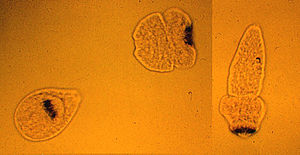Real tapeworms
| Real tapeworms | ||||||||||||
|---|---|---|---|---|---|---|---|---|---|---|---|---|

Beef tapeworm ( Taenia saginata ) |
||||||||||||
| Systematics | ||||||||||||
|
||||||||||||
| Scientific name | ||||||||||||
| Eucestoda | ||||||||||||
| Southwell , 1930 | ||||||||||||
| Orders | ||||||||||||
The genuine tapeworms ( Eucestoda ) are parasitically living worms in the intestines of vertebrates . The greatest biodiversity is found in fish . They occur all over the world.
Tapeworms are named after their final host. The tapeworms of humans, which bear the name of the intermediate host, are an exception: the beef tapeworm Moniezia lives as an adult in cattle and has a horn mite as an intermediate host, the beef tapeworm Taenia lives in humans and has cattle as an intermediate host.
features
The body of the real tapeworm (Eucestoda) resembles a flattened band (hence the name), which consists of individual, segment-like proglottids (singular: proglottis). Each proglottis contains male and female genital organs.
The Cestoda are also hermaphrodites and produce a huge number of offspring through mutual copulation. Only among the Eucestoda is it very common to find self-insemination.
In contrast, the more original tapeworm groups ( monozoic tapeworms ) only have a single genital set. All tapeworms are hermaphrodites, neither as a larva nor as an adult have an intestine and have a special outer skin that is built up as a syncytium .
On the head ( scolex ) of the tapeworm there are organs of attachment, either simple attachment pits or more complex suction cups, as well as wreaths of hooks with which the worm can hold on to the intestine of the host. The size of the tapeworm varies between 3 millimeters as in the fox tapeworm ( Echinococcus multilocularis ) and up to 20 meters in the fish tapeworm ( Diphyllobothrium latum ).
Life cycle
The infested final host secretes species-specific fertilized oncospheres or proglottids, which the tapeworm releases. In this case, fertilization can take place as self-fertilization, especially in the longer species, with the male proglottids near the head serving to inseminate the female proglottids further back. As a rule, however, there are multiple infections, and reproduction then takes place almost exclusively bisexual.
The six-hook larva ( Hexacanthlarve ) hatches from the eggs and has to be picked up by an intermediate host . There it is stored in the tissue and is called a metacestode . The worm now remains dormant in the tissue until the carrier (e.g. pig, dog, fish) serves as food for a suitable host (e.g. human, dog). The worm is now released in its intestines and settles. The new host thus becomes the new final host , in which the worm lives as a commensal (feeding community) or parasite .
Harmful effect
The worm itself is usually harmless to the ultimate host if the infestation is moderate. The host can only lose weight if the number is too high . The real danger comes from the metacestodes, which become embedded in the tissue and displace healthy tissue there or destroy entire organs through "cancerous" growth, as is the case with the hydatid formation of the fox tapeworm ( Echinococcus multilocularis ).
Systematics of tapeworms
While the monozoic tapeworms of other taxa are usually little known, the Eucestoda belong to a number of very well-known and medically relevant species, such as:
- Fish tapeworm ( Diphyllobothrium latum )
- (Tripartite) dog tapeworm ( Echinococcus granulosus )
- Fox tapeworm ( Echinococcus multilocularis )
- Beef tapeworm ( Taenia saginata )
- Pork tapeworm ( Taenia solium )
- Dwarf tapeworm ( Hymenolepis nana )
See also
literature
- C. Arme, PW Pappas (Ed.): Biology of the Eucestoda. 2 volumes. Academic Press, London et al. 1983, ISBN 0-12-062101-0 (Vol. 1), ISBN 0-12-062102-9 (Vol. 2).
- Peter Ax : The Metazoa system. A textbook on phylogenetic systematics. Volume 2. Gustav Fischer Verlag, Stuttgart et al. 1999, ISBN 3-437-35528-7 .
- Johannes Dönges: Parasitology. With special consideration of human pathogenic forms. 2nd, revised and expanded edition. Thieme, Stuttgart et al. 1988, ISBN 3-13-579902-6 .
- K. Odening: 7th tribe of Plathelminthes. In: Alfred Kaestner : Textbook of special zoology. Volume 1: Invertebrates. Part 2: Hans-Eckhard Gruner (Ed.): Cnidaria, Ctenophora, Mesozoa, Plathelminthes, Nemertini, Entoprocta, Nemathelminthes, Priapulida. 4th, completely revised edition. Fischer, Jena 1984, pp. 341-440.
- Reinhard Rieger : Plathelminths, flatworms. In: Wilfried Westheide , Reinhard Rieger (Ed.): Special Zoology. Part 1: Protozoa and invertebrates. Gustav Fischer Verlag, Stuttgart et al. 1996, ISBN 3-437-20515-3 , pp. 243-247.
